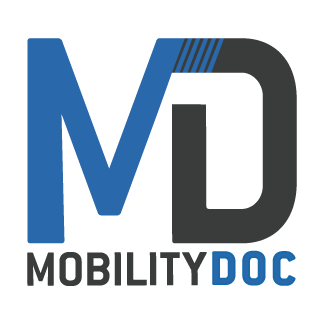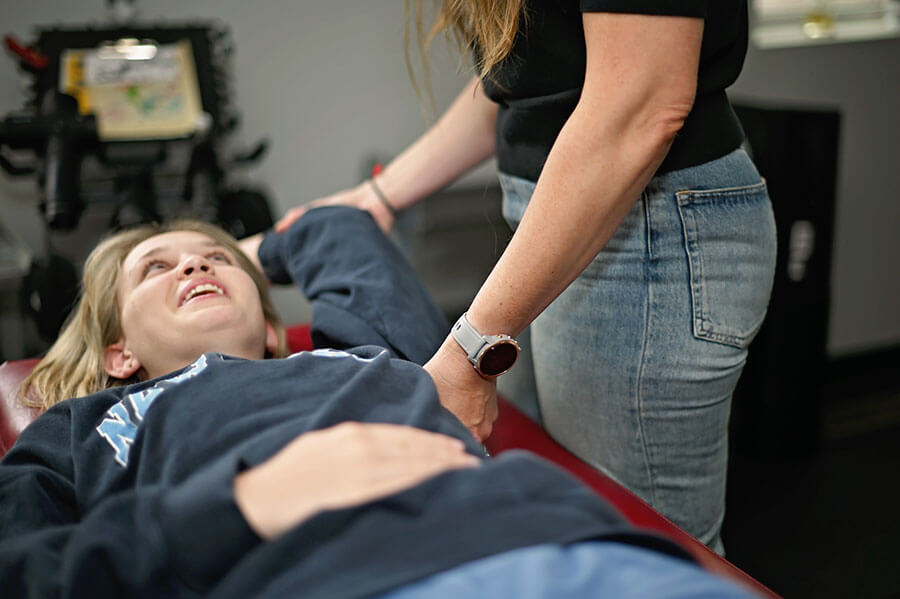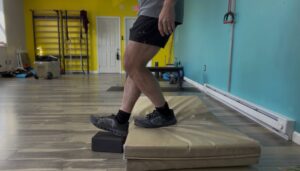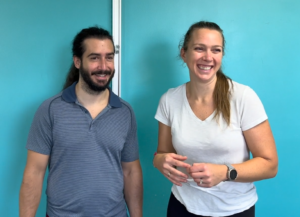This is a 2 part Shoulder Mobility series so if you missed Part 1, I highly suggest you check it out!
In part 1, we talked about how the scapula (shoulder blade) and the humerus (upper arm bone) work together. You may be thinking that there can’t be more to your shoulder than the 2 main components we already talked about. However, this week we are going to tackle a surprising part of how your shoulder moves that most people wouldn’t consider. Your spine. Let’s explore how the spine moves, the role the spine plays in our shoulder mobility, and how to keep it flexible.
There are three curves in the spine. The lowest one called lumbar lordosis, the middle one called the thoracic kyphosis, and finally the curve at the top called the cervical lordosis. These are more casually referred to as the lower back, middle back, and upper back with many of us considering our upper back as our neck. The portion we are focusing on today is the thoracic spine or middle back.
Anatomy of the Upper Back
This portion of our back is made up of 12 vertebrae. They start from the bottom of your ribcage, and go all the way up to the base of your neck. These vertebrae need flexibility and movement to move forward, backward, and rotate. This movement can be hard to find because of the curves size. Let’s not forget the special addition of 12 bones attached to each side. If you’re wondering what those might be, it’s your ribs. Having the ribs attached to the spine means we have less flexion. Flexion is the ability of the vertebrae to move forward and backward. Flexion and the ability to rotate in our middle back are so closely related that when you’re able to do one, you often help the other.
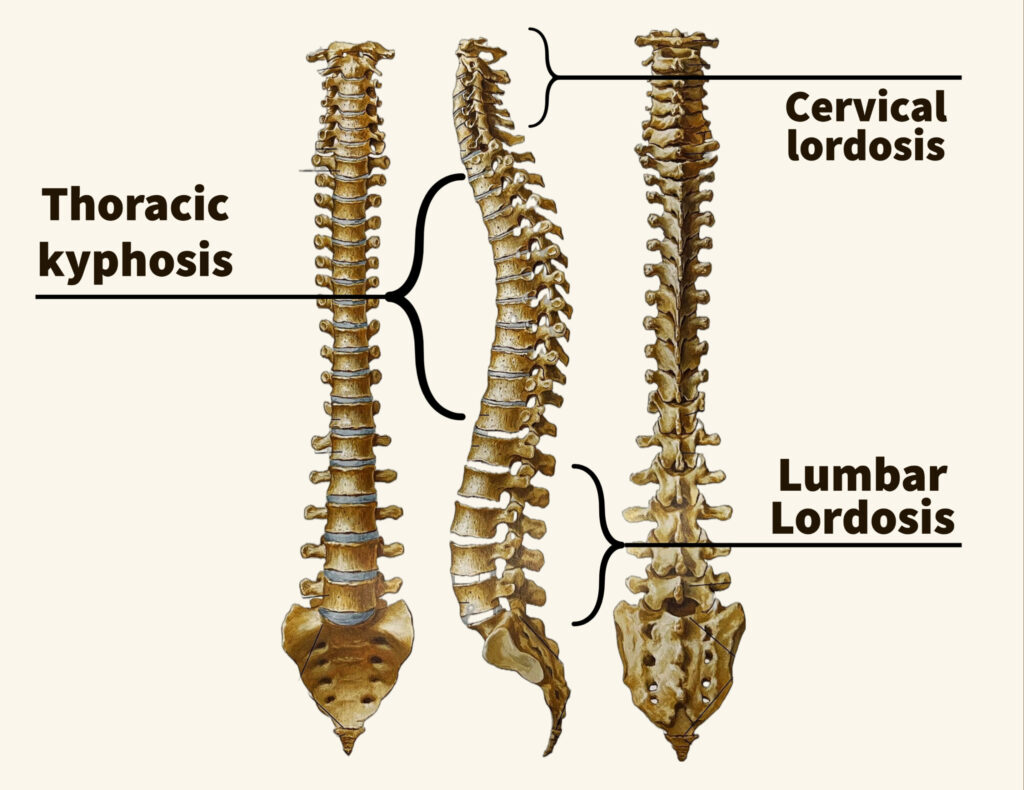
Many of us think we are moving our middle back when really we are retracting (bringing together) our shoulder blades. To create the movement you don’t want to move your shoulder heads (upper arm bone), shoulder blades, or ribs at all. Think about rounding your middle back as much as you can like a cat. Then do the opposite by letting the same part of your back fall forward to the front of your chest. I use the word fall because if I think push, I automatically start engaging other muscles. If you’re used to using your shoulder blades to do this, it can be hard at first! Don’t be surprised if it takes a few tries to feel it. It is a very small movement that most of us don’t even realize is working for us.
Challenges With Limited Mobility
Sometimes overlooked, this portion of our spine is incredibly important. The middle back is truly… in the middle of things! You can almost think of it as a mediator in a debate. The middle back works together with the other parts of the body to make sure everything stays on track. There is an interdependence here. When the mediator, or middle back, starts to get shut out, things start to go south. When one part of the body starts to under perform, one or more of the other parts need to compensate. This can result in being a silent contributor to dysfunction of these other body parts. For instance, if you start losing mobility in your middle back, don’t be surprised if you start experiencing shoulder pain.
This doesn’t just limit our every day activity, but makes a big impact on sports. For runners it means the ability to breathe more fully and move better, therefore running economically. In weightlifting, this shoulder mobility allows you to hit all the positions you need to without any pain. When golfing, not having this range of motion would cause you to hook your swing and short change your distance. We could go on and on about how this tiny aspect has a huge impact on just about everything.

Shoulder Mobility
How does this tie into our shoulder mobility? When I am thinking about shoulder movement, I roll it in circles, lift my arm in all different directions, but not once do I consider how my upper back is moving to help it get there. The very beginning of how your shoulder moves actually starts here. In order for your shoulder blade to move smoothly along the back of your ribs, your middle back needs to be able to extend forward towards your sternum.
This flexibility is challenged because we spend so much time rounding forward. The use of cell phones, tablets, computers, and generally bad posture all have a role to play. Often our thoracic spine ends up getting stiff. We lose our extention and rotation abilities and it is no coincidence they happen together. With the spine not working the way it is supposed to, it is pretty much impossible for us to keep our upper arms and shoulder blades in the right positions to move well.
Mobilizing the Area
Since we learned how this part of our back is linked to so many other areas, we want to make sure we take good care of it. Our middle back can’t move properly if the muscles around it are too tight and our shoulders are pushed forward. Dr. Chloe is going to lead us in an exercise that will help gain mobility in this region of the body. We suggest using a mat but it’s not necessary.
Our seated shoulder extension stretch allows you to open up the front of your shoulder while getting some extension through your thoracic spine. This exercise builds on last week’s shoulder mobility exercises by continuing to stretch and open your chest.
Watch the seated shoulder extension stretch video to learn more:
Keeping Your Shoulder Mobility
Over the past 2 weeks we have learned a lot about how the shoulder functions and how to keep it moving well. We know about some common issues people face with shoulder mobility and how we can fix it. It’s time to take action! The mobility exercises given here are an excellent way to maintain your shoulder health. In only 15 minutes a day you can complete all 3 exercises. It takes a little bit of dedication, but honestly not that much time! Most of all, we know you can do it.
If you haven’t already joined our 10 Day Shoulder Mobility Challenge it’s not too late! We want you to gain mobility and all of the benefits that come along with it! I know you’re thinking… but my favorite show is on tonight. Well, I have great news for you! You can do the challenge WHILE your favorite show is on. All you have to do is give it a try. Once you do, you won’t regret it. We would love to see your progress so tag us @mobility-doc on Instagram or Facebook. In case you missed it last week, here is the video.
Are shoulders your problem area? If you liked this video but you’re looking for more, try our at home MDRx shoulder program. It is $15 for a 4 week fully comprehensive rehabilitative program. It is ideal for people transitioning out of regular physical therapy or for those who know they need a little extra. You will improve your overall mobility stability and strength through the joint.
